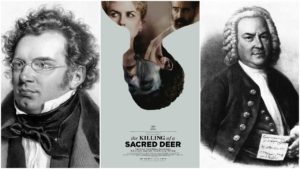
Opera Meets Film: How Bach & Schubert Provide Thematic Unity to Prologue & Epilogue of ‘The Killing of a Sacred Deer’
By David Salazar“Opera Meets Film” is a feature dedicated to exploring the way that opera has been employed in cinema. We will select a section or a film in its entirety, highlighting the impact that utilizing the operatic form or sections from an opera can alter our perception of a film that we are viewing. This week’s installment features Yorgos Lanthimos’ “The Killing of a Sacred Deer.” As always Spoilers Ahead.
While Yorgos Lanthimos’ film “The Killing of a Sacred Deer” does not feature any passages from operas, the film’s prologue and epilogue are framed by two choral moments by Schubert and Bach (both opening pieces in each respective oeuvre) that definitely support the film’s operatic intensity.
Before the film’s first shot we hear the opening chords of “Jesus Christus schwebt am Kreuze” from Schubert’s “Stabat Mater.” Jesus hanging on the cross is painful image in Christianity but it also symbolizes his rebirth. In this film, that very concept is twisted in a disturbing manner because moments later, after seconds of black, we get our first image – a human heart out in the open, pumping violently. It’s a shocking visual and over the choral entrance of the piece, it feels all the more sacred; the camera cranes up, further and further from the image, revealing hands working on it in an operating room.
The music continues as the title of the film appears before cutting back to a garbage can into which the rags and gloves used in the operation are being deposited. The overhead image matches that of the heart, creating a connection between the two images. Later in the film, we will learn that this operation was a failure and at the core of what sets the conflict in motion. The passage draws to its conclusion, the final notes hanging on the image of the garbage can, but the camera, instead of craning away from it, moves toward it in a direct reversal of the film’s opening shot. A human life has been disposed off. Where Christ’s sacrificed was meant as a redemption for the flaws of humankind, here, the death of one human must be redeemed by the death another, equally innocent person.
(Warning: The clip below has some graphic imagery)
The film then follows as Steven, the surgeon responsible for this death, deals with the son of the dead patient Martin. Martin demands that Steven trade a life for a life to set things back in equilibrium. His demand specifically asks that Steven murder one of his two children or his wife. Moreover, it seems that Martin’s threat is not one to mess with as he shows God-like prescience in stating what will happen to Steven’s children if he does not act quickly. In many ways, Steven is a God-like figure exacting revenge for the death of a family member (a subversion of Jesus’ sacrifice providing spiritual healing in the eyes of God).
After much difficulty, Steven murders his youngest son. And so it is that as he stares at his son’s bleeding corpse on his couch, we start to hear the strings emerge in G minor, performing “Herr, unser Herrscher” from Bach’s famed St. John’s Passion. This piece has been renowned for its mix of dread and triumph, taking the perspective of the mourners, mockers, and man on the cross all at once.
As with the opening Schubert piece, we are back to a setting of the crucifixion, but the meaning is different this time around because the sacred deer is another. But the film suggests that the sacrifice goes deeper than killing off one person with a great emphasis on the interchange of glances by Martin and Kim, who previously expressed interest in him. But it isn’t a look of romantic longing. The imagery is as ambiguous (or perhaps made ambiguous) by Bach’s equally complex score, but the suggestion is a strange connection between the two. For once, they both seem to understand the pain the other is feeling at losing a beloved family member.
The family gets up and starts walking away, Kim’s glance toward Martin the main focus until eventually the three remaining members exit the restaurant. The film cuts one last time toward a closeup of Martin’s face as he looks on, alone and satisfied. The shot cuts away right when the final “bist” of the chorus cuts off.
The final lines of the chorus are “Show us through your passion, that you, the true son of God, at all times, even in deepest humiliation, are glorified.” It can’t be lost on anyone that the film’s first and final images are connected by bloodline and the thematic material of both pieces of music, subverted with the son redeeming his father’s death.
Categories
Opera Meets Film

